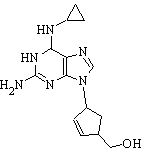A major government clinical trial comparing three HIV treatments stopped the arm using abacavir plus AZT plus 3TC (Trizivir[R]) alone, after patients in that arm " experienced virologic failure earlier and more frequently than patients who were randomized to receive either of the other two treatment regimens being evaluated in the study." However, all three of the study arms seemed to do well virologically, given the relatively advanced HIV infection the volunteers started with. And "there were no concerns about the toxicity of the study drugs."
This trial (known as AACTG protocol A5095) compared abacavir plus AZT plus 3TC vs. efavirenz (Sustiva[R]) plus AZT plus 3TC, vs. all four drugs (abacavir plus efavirenz plus AZT plus 3TC). In this study the volunteers were antiretroviral naive, but started with a high viral load (median over 78,000 copies, with 43% of the volunteers having over 100,000) and low CD4 count (median 238). A data review at 32 weeks found that 21% of those randomly assigned to the Trizivir alone still had a viral load over 200 copies after at least 16 weeks of treatment (which was defined as "virologic failure" in this study), compared to 10% of the volunteers in the other two groups combined. The difference was seen both in the group with viral load over 100,000 copies when they started the trial, and the group with lower viral load. Because the difference was statistically significant and met the pre-determined standard for stopping a treatment arm, the Data Safety Monitoring Board (DSMB) had no choice but to stop abacavir plus A ZT plus 3TC and offer the participants other treatment. A March 10, 2003, letter from the U.S. Division of AIDS to the researchers, containing all the information initially available, is at: http://www.niaid.nih.gov/daids/default.htm.
Because the other two arms of this trial are continuing, the DSMB released the least amount of information necessary, to avoid any risk of biasing study results. For example, we do not know if the virologic "failure" usually meant a viral load barely above 200, or considerably higher. Also, we have no information about adherence and missing doses. The study was double-blinded and placebo controlled, so all volunteers took five pills at night and two in the morning, and if some were more careless about missing the morning than the evening dose, that could have biased the result in the direction seen, since all the efavirenz was in the evening dose, but every drug in the Trizivir-only arm would have been affected by missing the medicine in the morning.
Some additional information will be submitted to the International AIDS Society conference, July 13-17 in Paris; however, the other two study arms will still be ongoing, so full information may not be available even then. Continuing the two remaining arms will help address the question of whether adding a fourth drug to certain 3-drug HAART combination regimens provides enough additional virologic benefit to be worth the added cost in side effects and expense.
Comment
There is no perfect HIV treatment, and we have not seen any rush to change drug regimens because this Trizivir arm was stopped. The new information does have doctors' attention, and will be reflected in medical consensus as more is learned.
COPYRIGHT 2003 John S. James
COPYRIGHT 2003 Gale Group



